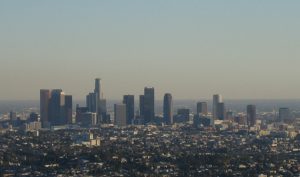
An NCCOS-funded study found that nutrient-laden, urban runoff is fueling algal blooms in Southern California’s coastal waters that are acidifying the water and depleting it of oxygen, making habitat unsuitable for marine organisms. The research team’s modeling shows the trend is likely to worsen under future climate change scenarios.
The Southern California Bight, an area of ocean located between the Baja Peninsula and Point Conception in Santa Barbara County, borders a population of 23 million people, including the Greater Los Angeles area, that discharges approximately 8 million cubic meters of nutrient-enriched stormwater and wastewater into the ocean each day. Considering that the U.S. West Coast is already experiencing increased hypoxia (low oxygen) and acidification from climate change, the effect of local human nutrient inputs exacerbates this trend.
The research is the result of multiple projects funded by NCCOS (under the Ecology and Oceanography of Harmful Algal Blooms Program, and the Coastal Hypoxia Research Program) and NOAA’s Ocean Acidification Program (Ocean Acidification and Hypoxia).

